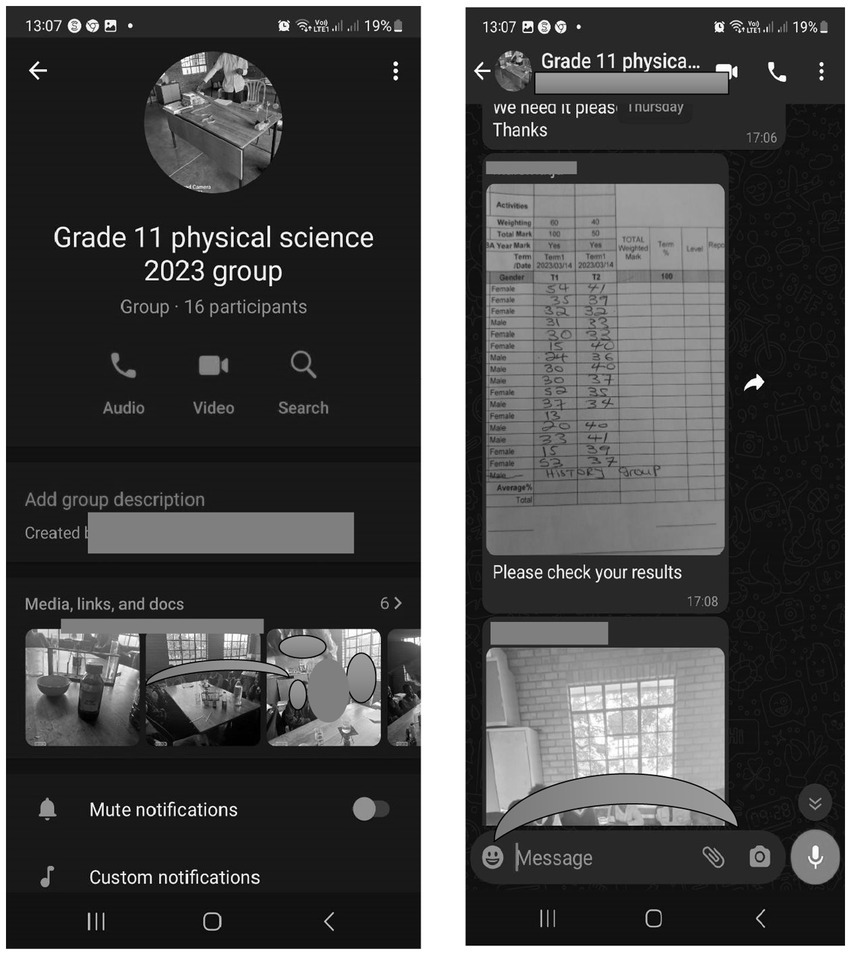- Department of Science and Technology Education, University of South Africa, Pretoria, South Africa
Aim: This study reports on the Physical Sciences teacher’s teaching difficulties when teaching with the Rural Blended Learning Strategy (RBLS), which is based on the flipped classroom approach, and the implications of that on his self-directedness, social presence, and teaching presence.
Methods: It was a qualitative case study which relied on semi-structured interviews, focus group interviews, and classroom observations of the Physical Sciences learning process. The sampled population consisted of one Physical Sciences teacher and his learners, who were purposefully sampled as their school is a rural school. The data were photographed, audio, and video recorded to provide pictures and a transcript. The RBLS’s Detailed Analysis System was also crucial in the data analysis process.
Results: In addition to inadequate institutional support and the Physical Sciences teacher’s insufficient technology skills, the teacher was not self-directed since he did not improvise through his smartphone to flip the classroom by blending the learning process at school or from the comfort of his home, when the laptop he shares with his colleagues was unavailable. This eliminated the possibility of shaping self-directed learners in his class. Additionally, by taking time to set up the learning management system and not using video-conferencing platforms, the teacher demonstrated an inadequate teaching presence, inhibiting the social presence in the process.
Conclusion: Failure and reluctance from the teacher to implement the RBLS demonstrate insufficient self-directedness, teaching, and social presence. We recommend a sustained, long-term professional development on the RBLS to ensure its effective integration in the Physical Science teaching practice, while the School Governing Bodies (SGBs) fine-tune their institutional support.
Introduction
Blended learning has been in use for some period now. According to Pappas (2015), distance learning was initiated in 1840 by Sir Isaac Pitman, who used abbreviated texts to instruct learners via postcards that they would return for marking and feedback. In the past, integrated learning consisted of a combination of traditional classrooms, laboratories, books, and pamphlets (Singh, 2021). Furthermore, between 1960 and 1970, the introduction of computer-based training became inevitable, with many employees gaining access to training materials in soft copies (Pappas, 2015). Learners were trained using video-based platforms in the 1970s. Later, institutions such as Stanford University and the Open University began to combine distance education, face-to-face learning, and one-on-one tutorials (Nicholson, 2019). In addition, they tested utilizing TV-based virtual graduations (Nicholson, 2019). It was, in fact, in the late 90s that the idea for blended learning was gaining consideration (Güzer and Caner, 2014). Güzer and Caner (2014) then demarcated the initiation of blended learning into three eras: the first attempts period (1999–2002), the definition period (2003–2006), and the popularity period (2007–2009).
There are many positive reports about blended learning. For example, in their study, Warren et al. (2021) demonstrated that blended learning improves learners’ self-efficacy. Equally so, Rasheed et al. (2021) highlighted how blended learning implementation positively impacted learners’ performances. Heart et al. (2022) demonstrated that the majority of learners in the study (84%) preferred being taught through blended learning. However, despite this positive impact of blended learning, studies demonstrate that the problems remain with the teachers who are supposed to implement it. For example, Mhlanga (2021) indicated inequality, the digital divide, limited resources, and insufficient computer skills as inhibitors for the implementation of blended learning. In fact, the International Monetary Fund (IMF) (2020) paints a blurry picture of how unequal South Africa is and how it struggles to recover from the legacy of Apartheid and its impact. To make matters worse, the majority of South Africa is rural—about six out of nine provinces (Hall, 2023). This implies that most schools are under-resourced, as indicated by Mhlanga (2021), creating an inhibition to efficient implementation of e-learning and blended learning. It would be expected that proper connectivity, devices, policies, and institutional support, among others, would be prerequisites for the implementation of blended learning (Singh, 2021). To place this study in the ongoing debates about blended learning, the following sections provide the theoretical contexts of the study.
Self-directed learning
However, the issue may not only be insufficient skills indicated above but also the will of the teachers to implement blended learning. Self-directness expects teachers to take the initiative in their learning when implementing a strategy (Kapur, 2019). It would therefore be expected that Physical Sciences teachers implement a blended learning strategy on their own. Furthermore, there are different blended learning models available, giving teachers an abundance of options. For example, Schenk (2023) identified 12 different models, which include the following: flipped classroom, station rotation, individual rotation, flex model, A le Carte, online driver model, project-based learning, problem-based learning, adaptive model, hybrid learning, virtual game-based learning, and mastery-based learning models. However, we found the Rural Blended Learning Strategy (RBLS) by Nkanyani (2023), which is designed in a flipped classroom manner, to be relevant for this study, given the fact that it is designed specifically to aid the teaching of Physical Sciences in rural schools.
Community of inquiry framework
Other elements, which this study focuses on, are the social and teaching presence that emanate from the Community of Inquiry framework (Garrison and Arbaugh, 2007), shown in Figure 1. According to the framework, discussions, debates, deliberations, and inquiries should be the norm in the learning context since it is a community. Furthermore, the framework views learners as unique individuals who should become active and build on their communication abilities.
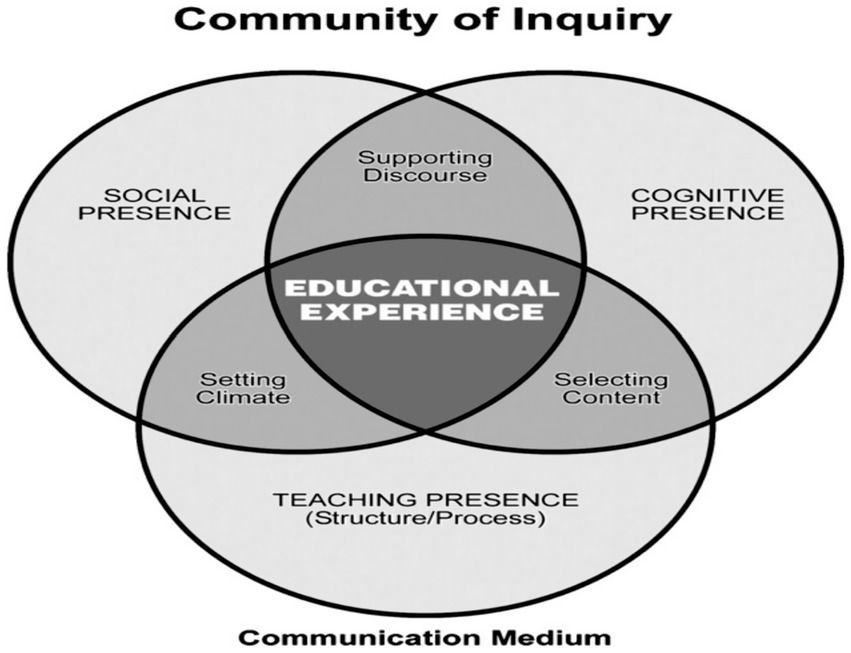
Figure 1. The community of inquiry framework [adapted from Garrison and Arbaugh (2007)].
In the context of this study, we wanted to understand how the RBLS shaped the teaching by focusing on engagements and discourses. It was expected that such would occur in the blended learning platform, by taking part in simulated exercises and group projects.
Social presence specifically deals with the potential of individuals within the Community of Inquiry to advance their individual traits for their community, consequently portraying themselves as authentic people in the online world (Garrison, 2000). The community in the context of this study is a rural area, which is too remote and has minimal crucial resources, such as electricity, poor internet connectivity, and the unavailability of libraries and community computer centers. Hence, it was prudent to have a better understanding of the extent of these negativities on the Physical Sciences teaching practice through the RBLS. Moreover, the social presence provides an arena for an individual to understand his or her feelings (Oh et al., 2018). Consequently, the online system would prioritize social presence to its maximum (Oh et al., 2018). A classroom itself is a social context, which makes the understanding of the social presence important, since RBLS was implemented in class. Moreover, the teacher would create a social context in a flipped classroom approach. The teaching presence can be classified into specific functioning groups, which may be carried out by the teacher: the design of the educational experience and facilitation (Garrison, 2000). The first, the design of the educational experience, involves the selection, arrangement, and main facilitation of the lesson and, additionally, the creation of lesson exercises and examinations (Garrison, 2000). Facilitation is a task that is equally distributed to all involved, be it the teacher, learners and others partaking in the process (Garrison and Arbaugh, 2007). Moreover, with effective teaching presence prevailing, efficient teaching and learning with appropriate instructions and outcomes are attained (Caskurlu et al., 2020). Therefore, the teaching presence in this regard involved how the Physical Sciences teacher created the social media (SM), learning management system (LMS), and video-conferencing (VC) platforms to consequently add learners and create a community of engagement within the platforms, in accordance with the RBLS. Through the teaching presence, the teacher has the potential to facilitate and direct the social and cognitive presence to achieve high-quality learning outcomes for learners (Cui and Wang, 2023).
Several studies highlighted challenges faced by teachers in implementing blended learning. For instance, Rasheed et al. (2021) stated that teachers’ challenges in blended learning pertain to the application of technology in class. The same was amplified by Liping et al. (2023) and Ramorola (2013). This study intended to explore the Physical Sciences teacher’s teaching difficulties of flipping his classroom with the RBLS and the implications of that on his self-directedness, social presence, and teaching presence.
The following research questions guided the study:
RQ1: What difficulties does a Physical Sciences teacher face when flipping his classroom with the RBLS?
RQ2: What are the implications of flipping the Physical Sciences classroom with the RBLS on self-directed learning?
RQ3: How does flipping the Physical Sciences classroom with the RBLS affect the social and teaching presence?
Blended learning implementation model
This study employed the RBLS by Nkanyani (2023) as a model. This pedagogical model is inspired by theories such as social constructivism, where learning takes place from a social perspective, with learners building on their knowledge through engagement with each other (Ardiansyah and Ujihanti, 2018) and with their teachers (Kola, 2017). These engagements complement well with the nature of blended learning, which is embedded in continuous engagements in class and on the online platform (Moskal et al., 2013). The social aspect of learning ties in well with the socio-cultural theory by Vygotsky, which puts an emphasis on the cultural context of learning, which includes schools, their communities and homes. The cultural aspect also focuses on how learning and teaching take place at school, and how they use resources such as computers, technology, and other resources. In the context of blended learning, the focus is on how learners and teachers engage on the face-to-face and online platforms. During the design of the RBLS, the author considered the challenges experienced by the rural communities in terms of electricity connectivity, internet connectivity, and the number of devices. That also allowed authors to note the opportunities in that context, which led to the ultimate design of the strategy. What was crucial to highlight was that even though the RBLS was designed for rural classes, its implementation cannot be generalizable to all rural areas, as rural areas differ in their nature. According to the RBLS, learning is not a one-way street, but rather a series of interactions and forms. As a result, it consists of triangular shapes (see Figure 2) with each point represented by an individual media or platform and approach. Furthermore, even though blended learning can be implemented in any mode or a combination of models indicated above, the RBLS was embedded in the flipped classroom model. Hence, the double arrow in between represents the back-and-forth engagement, highlighting the movement’s flexibility and the fact that it is not a linear path. It also refers to the flipping of the classroom from face-to-face to online platforms, where the framework is built. In any order, these two platforms can be flipped, one after the other. There is a possibility that the online component, where learners complete an online quiz as class preparation, comes before the in-person classroom session. To address prior knowledge, the teacher starts the in-person Physical Sciences lesson by providing feedback on the online quiz and class preparation assignment. This is because learners’ self-efficacy is influenced over time by a variety of factors, including prior knowledge (Simsar and Davidson, 2020). Similarly, evaluating prior knowledge has a positive impact on learners’ engagement (Dong et al., 2020). The teacher then provides guidance, outlining the lesson’s objectives and specifics for that day. The teacher then conducts the class in a way that promotes collaborative learning, which is in line with the curriculum’s goal of encouraging active learning in Physical Sciences (Department of Basic Education (DBE), 2011). It is important for teachers to connect theory to practice in their instruction (Department of Basic Education (DBE), 2011). The kinds of instructional techniques and explanatory frameworks would be crucial (Mudau, 2016). Furthermore, the lesson should be designed to promote dialogic discourse and discourage authoritative discourse (Mudau and Netshivhumbe, 2022). After that, a classroom activity is used to evaluate the learning process, and feedback is given. Wilson (2018) provided evidence of how assessment in the classroom enhanced the educational process. The next step would involve the teacher summarizing the lesson and providing guidelines for the online lesson that will come after the in-person lesson. The learners’ role would be to engage with their teacher and peers while adhering to the lesson objectives. After that, they would engage in classroom activities and get teacher feedback. The online classroom component will then take over the learning process, and this will happen after regular school hours. The teacher will send instructions to the learners via text message or recorded asynchronous video from Microsoft Teams or Zoom when they log into the Google Classroom (GC) LMS. Throughout the process, communication between the teacher and learners would take place in the class comment section on the GC and SM platforms. Learners would take advantage of the chance to interact, talk, and ask clarifying questions. One benefit of this function is that participants can respond whenever it is most convenient for them. This could be especially useful in areas where network connectivity and persistent load shedding are issues. To align with 21st-century skills and comply with the introduction of the 4IR, the environment should also support the development of self-directed learning (SDL), social constructivism, and learner-centred/active learning (Evenhouse et al., 2023). Learners will be able to complete online tests in Google Forms or at-home or pre-class activities using Google Docs, thanks to the platform. A benefit of quizzes is that learners get answers right away. The teacher can choose to provide feedback on the assignments in-person or online in the next class. The teacher can then choose to upload extra materials that can help learners learn, like lab guidelines, notes, YouTube videos and links, past exam papers, worksheets, e-books, and additional resources. Through all these steps, the teacher would successfully flip the classroom through the RBLS (see Figure 2 and Table 1).
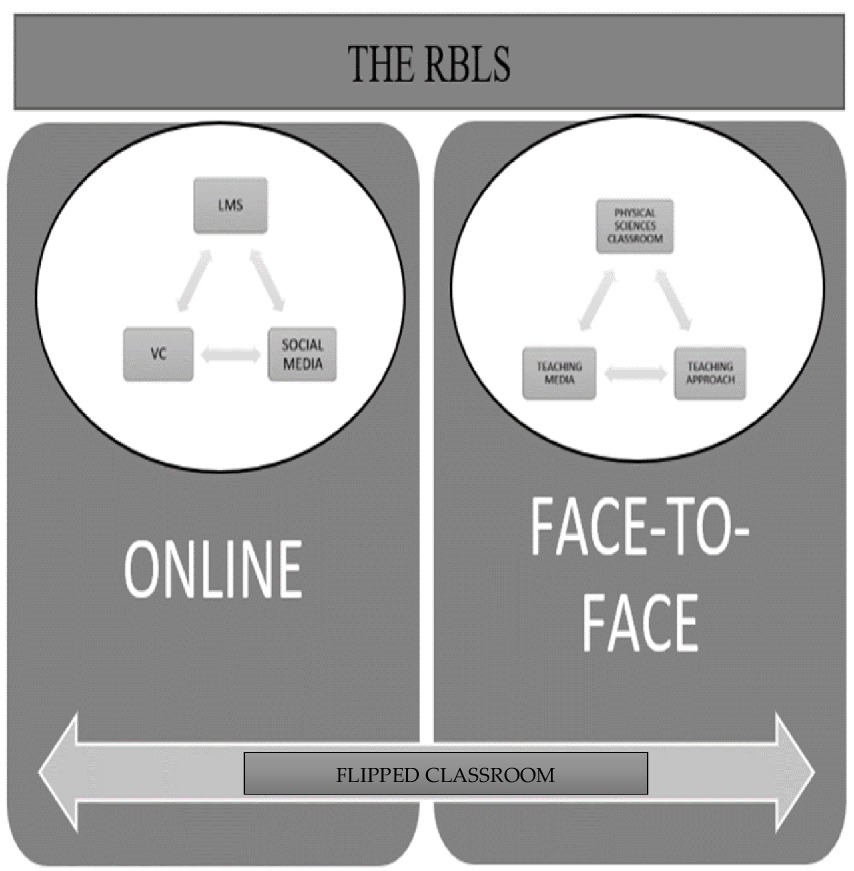
Figure 2. The Rural Blended Learning Strategy (RBLS) (Nkanyani, 2023).
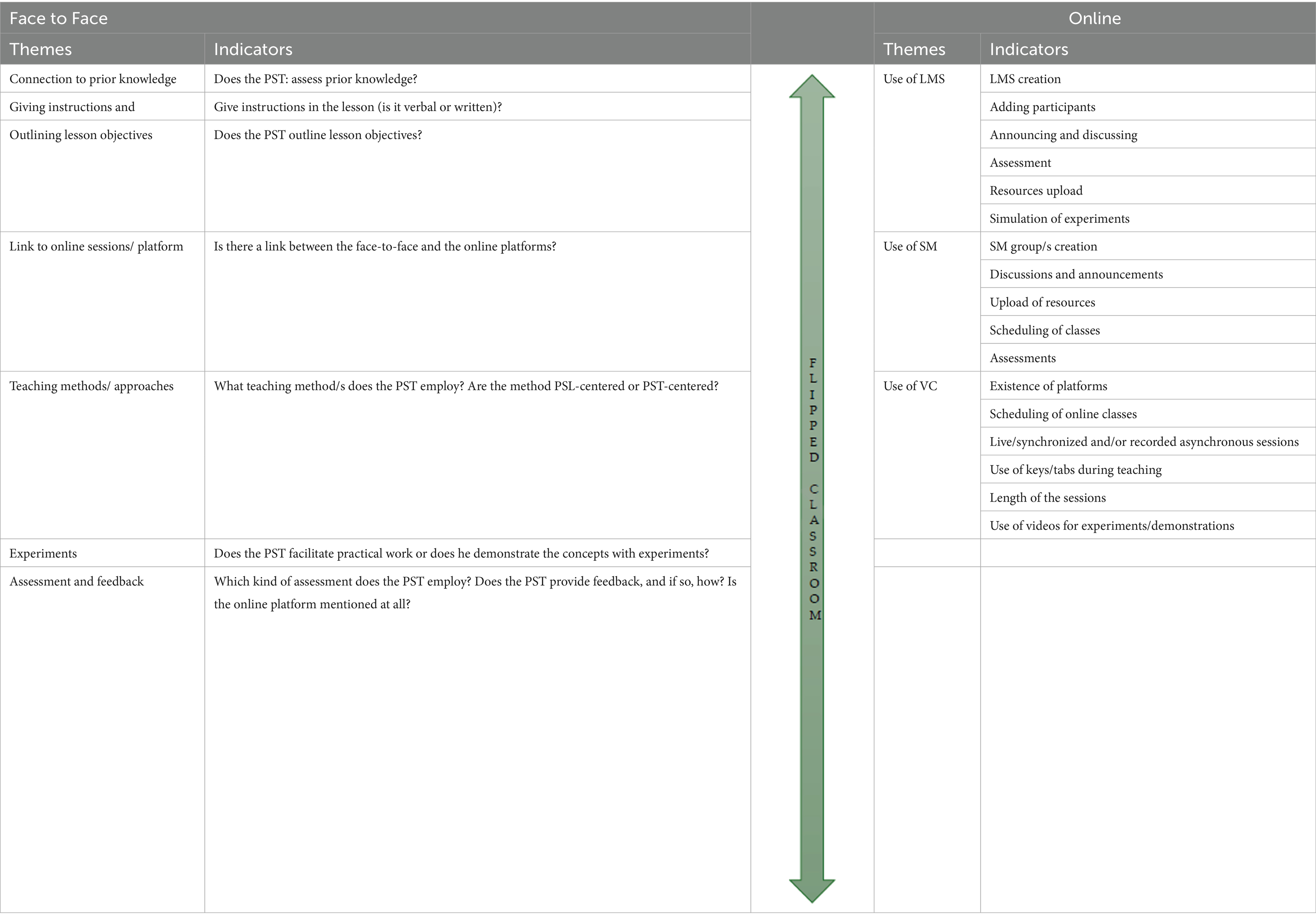
Table 1. The Detailed Analysis System (DAS) of the RBLS [adapted from Nkanyani et al. (2024)].
Google classroom
The RBLS utilizes GC as its preferred LMS. Because of its simplicity and friendliness, GC is not only one of the most favoured LMS but also has more benefits than drawbacks. Among its benefits are its free usage (Li et al., 2020; Zakaria et al., 2020) and its suitability for low-resource schools (Zakaria et al., 2020), which in our case are rural schools. Furthermore, according to Li et al. (2020), it is compatible with various devices, which is appropriate for this study, given that schools use a variety of devices (including PCs and laptops) and that some students even have cell phones. Li et al. (2020) stated that, among other things, GC bears and promotes the following characteristics: Assignments/Tasks, Ratings/measurements, Communication, Mobile App, and Privacy. Additionally, GC enables students to share resources with their instructors and with one another (Beaumont, 2018). Above all, due to its ability to connect to different Google Apps, learners are able to collaborate and work on the same activity using the same document (Beaumont, 2018). GC boosts learners’ motivation because it is so simple to use (Tuiloma et al., 2022).
Materials and methods
This study followed a qualitative approach of research. It was a single case study of the PST with the RBLS. Choosing a single case study was deliberate in order to provide for a thorough, context-rich exploration of how PST planned and implemented the RBLS during his teaching of Physical Science. Furthermore, data were also gathered from PSLs, enhancing it and making the Physical Science classroom a focus, rather than just the teacher. Data were collected through semi-structured interviews, focus groups and classroom observations. The semi-structured interviews were done with the PST after he taught three lessons with the RBLS. The focus group interviews were done with Physical Sciences PSLs, also after they were taught using the RBLS. Both audio recorders and cameras (video and photo) were used to capture the audio during interviews and pictures and videos during lesson observations. The recorded audio was used to produce transcripts for verbatim data analysis. The online component was also observed in the form of LMSs, SM, and VC platforms used.
Sampling
The study employed the purposeful sampling strategy (Evenhouse et al., 2023), selecting participants who possessed specific characteristics of interest (Li et al., 2020) and were critical in answering the research question. The participants were from a rural school in order to meet the criteria, hence a criterion sampling strategy. The participants were a PST and his Grade 10 PSLs.
Interventions
An induction was provided to the PST with his Educator Assistants (EAs) on the RBLS prior to its implementation. The focus was on online platforms such as GC and SM platforms such as WhatsApp, Twitter, and Facebook, from which the teacher (PST) had to choose from any combination of the three. The intention was to show the PST how to add Physical Sciences learners (PSLs) to the platforms and how to teach Physical Sciences in a flipped classroom manner, with the designed RBLS.
Moreover, the PST was inducted on the VC platforms such as Microsoft Teams and Zoom Meetings, where he and his EAs were taken through different functions of the platforms. More importantly, he was taken through on how to schedule and record sessions through the VC platforms and how to upload the recorded videos to the SM and GC platforms. In a way, the PST was expected to be flexible while simultaneously diversifying online platforms, in order to maximize the use of the RBLS to flip the Physical Sciences classroom.
Data analysis
Prior to analysis, the data gathered from semi-structured interviews, focus groups, and classroom observations were transcribed. Having responses from PST and PSLs allowed for the triangulation of data, comparing and validating PSL responses with PST responses and vice versa. Both the online and face-to-face components of the lesson were analyzed. The RBLS and the Detailed Analysis System (DAS) in Table 1 were essential in identifying and coding the key elements/themes that should be prioritized during data analysis. The flipped classroom concept served as the model for the design. The DAS included both the in-person and online components of learning, as it was created with blended learning in mind. Each component had themes (see Table 1), which were key during the analysis of the transcripts, videos, and screenshots of the online platforms. For the face-to-face class, the focus was on instructional aspects such as conducting a prior knowledge test, outlining lesson objectives, assessing student understanding, connecting the online platform to the in-person instruction, teaching methodology, conducting experiments or practical demonstrations, and providing feedback and assessment. We also checked the online platform to determine if the PST could teach Physical Sciences using the VC, SM, and GC LMS platforms. Whether the PST could make a connection between what was taught in the in-person setting and what was being learned on the online platform was another area of focus. The focus was on the potential of the PST to flip the Physical Science classroom post the interventions, according to DAS in Table 1.
Results
Consequently, a minimum of three lesson observations were made. The observations were made on both the online and face-to-face platforms. The first lesson was on the mass vs. acceleration experiment, whereas the second and third lessons were common test feedback on the topics of Electrostatics and Vectors in two dimensions, respectively.
Teaching with the RBLS
Face-to-face platform
Prior knowledge/link to online class
The PST started the first lesson, which was the force vs. acceleration experiment, as presented in Figure 3, by reading laboratory rules. Something that would be expected in a laboratory environment.
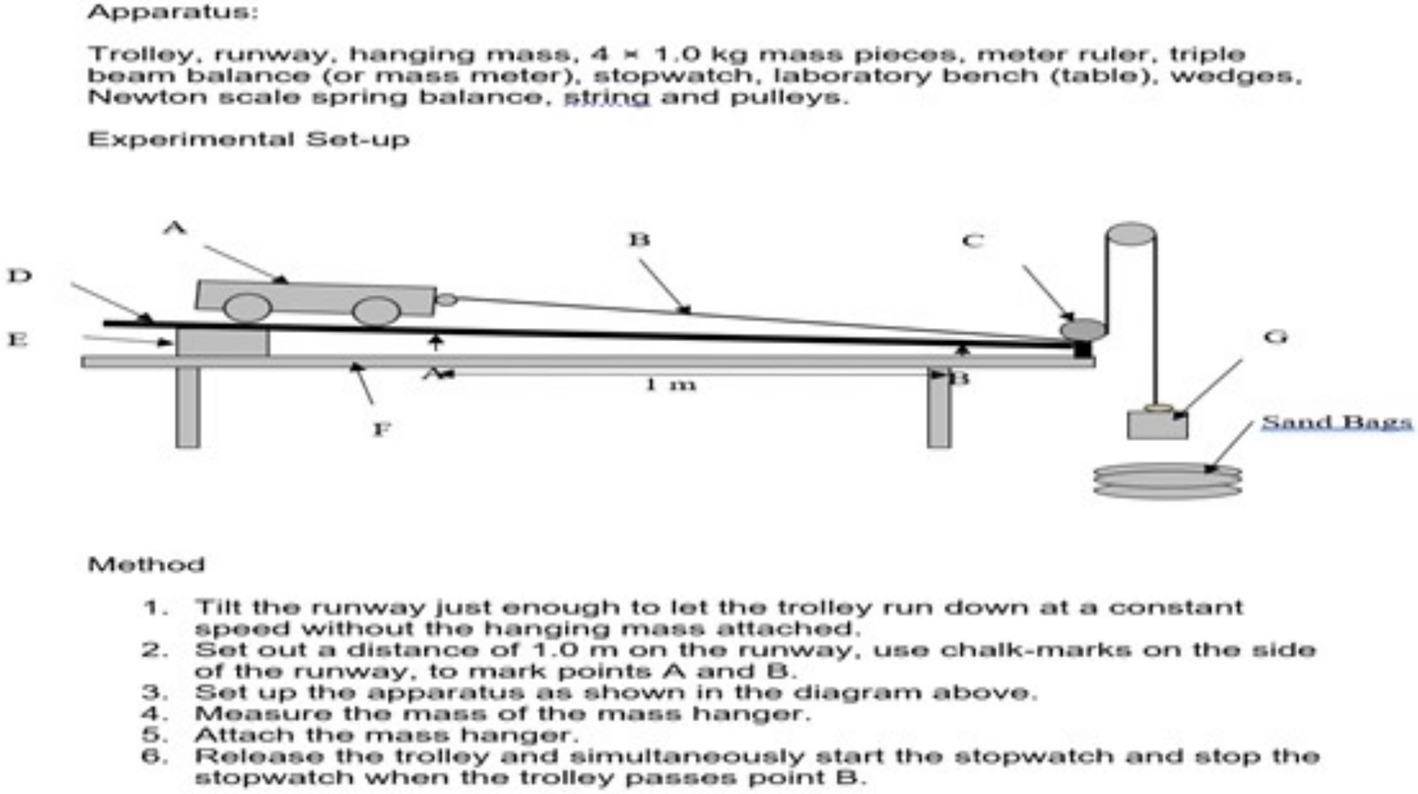
Figure 3. Showing an experimental setup and instructions for the force vs. acceleration Grade 11 practical.
He consequently took PSLs through the experiment. He took them through different apparatuses they would use, as presented in Figure 4. However, he had not linked PSLs to any previous knowledge nor made mention of any of the online platforms, consequently failing to flip the classroom as per the RBLS in Figure 1 and Table 1). This was a downside of implementing the RBLS, as Simsar and Davidson (2020) highlighted how prior knowledge, among others, has a prolonged effect on PSLs’ self-efficacy. Regarding the second and third lessons, the PST only reminded PSLs that the topic was already covered and that it should be treated as revision. He had never referred PSLs to any work or additional resources on the online platform/s, except after the third lesson, where he referred PSLs to the task he uploaded to WhatsApp and told them that they should send it back using the same platform. Similarly, the PST failed to use blended learning in a flipped manner during his teaching of Physical Sciences in this regard (Maher et al., 2015).
Teaching approach
The PST used a teacher-centered method in the experiment lesson. For example, after doing the experiment with some PSLs while others were observing, as presented in Figure 5, he resorted to grouping those PSLs, allowing them to do the experiment in their groups under his supervision, as presented in Figure 6. This was a good choice since learner-centeredness is one of the expected approaches in blended learning (Nkanyani et al., 2024).
However, that could not be repeated in lessons 2 and 3. He indicated that he wanted to save time, and since one PSL could not do all the required steps of the experiment due to its complexity:
“Yes, normally with practical’s we need to group them. Maybe because of time of time. And also, a practical, a single PSL, cannot do. Because you need to handle this and that one PSL need to handle stopwatch, another PSL need to, to handle the trolley, another PSL need to balance this and that another PSL need to make sure the place is clean. So, for a single PSL it will be difficult for him or her to carry out the experiment. The experiment is good for PSLs.”—PST
Nevertheless, his approach in the second and third lessons was dominantly PST-centred. For example, he was doing calculations on the board while at the same time asking for responses from PSLs, as presented in Figure 7.
He could have asked PSLs who did well in such questions to come and show others how they did it. However, he did that once, as presented in Figure 8 and never repeated it. He indicated that he had the issue of time in mind:
“The time that we are having. Contact time with PSLs, remember. The lesson is normally is a One-hour lesson. And sometimes we have to chase time. We need to make sure that, at least by the end of the of the lesson, then we have covered this and that. Remember, there is a curriculum that we need to cover, so I realise, or maybe if I give more time, more PSLs to come in front and show their method, then it may consume a lot of times.”—PST
Nevertheless, he and some PSLs had some engagements, even though he was not consistent. He did not provide PSLs an opportunity during their engagement with him to elaborate more. As a result, he was unable to provide sufficient room for social constructivism (Cunningham, 2021). Similarly, he used demonstration frameworks (Yang and Lu, 2023) to emphasize his teaching of the content. For example, when explaining the concept of charges in Electrostatics, he used the atomic structure to explain how charges are formed and which sub-atomic particles are involved, as presented in Figure 9.
Practical/experiment
The PST did not do any practical demonstrations or engage PSLs in hands-on activities in lessons 2 and 3. It was only in lesson 1, which was practical in nature, that an experiment was done. He indicated that since lessons 2 and 3 were based on feedback from the common test, he did not see a need because he had the issue of saving time in mind. Also, one of the feedback lessons was on gravitational forces, which was covered in experiment 1:
“And again, remember of one of the of the feedbacks that they have given them is based on Newtons laws and the practical is Newtons laws. So, you see you can you can relate the truth. So, they, get what they are understanding. What, what, do you mean about the gravitational force? What do you mean about acceleration? The tool that we are talking about, the pulley. Why is it important to, to have a pulley? What is the function of the pulley? the string that we are always, always, talking about to say? Hmm, hmm. Frictionless pulley or the, the, mass of the pulleys to what - what? Which way do they use in? Is it a mass-less you say this we can ignore the mass of the of the of the string? It’s like that. Even the trolley. We found out later, that they are not aware or when you. Talk about the trailer, talking about talking about, yes. So that demonstration here. Hmm, I think it worked a lot. They helped them a lot. They even also checking the angle of the runway. Say when you talk about the angle of incline, we are talking about something like this. I spoke about the gravitational force. Things like that. You may find that these PSLs were not aware.”—PST
However, it would have been expected that the PST would form a link between the theory and practice by referring PSLs to that practice. That approach could have not only led to PSLs’ increase in fascination about the topic under study, but it could have also created an efficient environment for learning (Department of Basic Education (DBE), 2011).
Assessment
The only visible assessment was during the first lesson—the experiment, which required PSLs to submit a report at their conclusion. He did not assess the PSLs in the other two lessons. He indicated that he used the lessons as an opportunity to show PSLs where they went wrong and how they should be able to go through answering questions to avoid losing easy marks. However, the PST could have given PSLs an assessment as extra work to do when they are free, but he did not do that. It was also important to check if his feedback was well received, given the fact that PSLs are still going to write the same content during the upcoming mid-year exams. This influenced the learning process negatively (Wilson, 2018).
Online platform
Use of the LMS platform
The PST had not created a GC platform during the first lesson observation. He only created it prior to the second lesson. Still, he was the only participant in the platform, with no PSL added, as presented in Figure 10. He indicated that the challenge emanated from the fact that he did not have a personal laptop but a staff laptop, which most of the teaching staff relied on:
“Okay. With the Google Classroom platform. I had some challenges myself. I’m not in a position of a laptop. Since we are competing for the laptop in school, so I do not have a personal laptop right now. It was stolen.”—PST
Yet, Kola (2017) indicated how compatible GC is with a variety of devices. As such, the PST could have used other devices, such as his smartphone. However, it appeared that it was the usage of GC that he struggled with, despite the training provided to him prior to the implementation of the designed RBLS:
Similarly, the PST attempted to use the GC platform to communicate with his PSLs, as presented in Figure 10. That was positive since engaging PSLs through the GC platform increases their motivation, as it would have provided a room for more advanced engagements (Kola, 2017; Li et al., 2020). Moreover, it would have allowed learners to get clarity on the content they could not understand during the face-to-face class, or him adding more information that he could not during the face-to-face classroom, consequently flipping the classroom. However, his attempt to use the GC platform did not bear any fruit as no PSL was added. The PST proceeded by uploading a task to the platform, as presented in Figure 11. Nonetheless, no PSL was there to do and submit the task, as PST indicated that he did not have a laptop to manage his smooth usage of the GC platform.
Furthermore, PSLs did not respond or engage with the PST since they were never told about the platform. The only thing the PST did was to ask for emails, and it ended there:
“No, no, no. He did not say anything.”—PSLs
Use of the SM platform
The PST utilized the SM platform to aid his teaching. By the first lesson, he had added 14 PSLs to the WhatsApp group. He even made announcements, such as when he reminded a PSL to submit the task, as presented in Figure 12. The PST also used the platform to report marks to the PSLs, as presented in Figure 13. Similarly, one PSL used the platform to engage the PST in activities he had promised to give them in the face-to-face classroom. Again, another opportunity to flip the classroom.
He proceeded and asked the PST to share resources in order to gradually introduce the PSLs to term 2 work. However, the PST shared a picture of Grade 8 PSLs doing the practical. He said he wanted to promote the practical work in science:
“It was not all about what I was doing class. It’s all about trying to promote Physical Sciences. The other challenge is that a small number of PSLs were doing Physical Sciences, so I’m promoting that and also they must they must feel comfortable, right? While other PSLs are saying this WhatsApp it’s not for, it’s not for them or other PSLs. Additionally, those pictures contain natural sciences’s best 8 learners and I’m not teaching that natural sciences.”—PST
Even though that was for a good course, it had nothing to do with what he was teaching in class. Therefore, the PST failed to use the WhatsApp platform effectively to flip the Physical Sciences classroom. Research has already indicated how SM has won the hearts of PSLs, increasing their excitement and teaching-learning experience (Ali, 2017).
The PST also used the WhatsApp platform to report marks to the PSLs, as presented in Figure 13.
Use of the VC platform/s
The PST had not used VC platforms to record and schedule sessions. He indicated that he had attempted it but failed:
“I tried it. I tried it. It’s not easy for me. I try it all and especially when I’m at home like that, but I could not get it right. I could not get it right. Yes, I tried, and I still want to try it.”—PST
He also repeated the issue of not having a laptop as another factor that led to the failure:
“I was not sure of where to where to start. Even the problem with the laptop because of I cannot take it from school and bring it here to home. Yeah.”—PST
This was a loss to the learning process, as Cilliers (2021) found that PSLs in their study had positively accepted the use of VC platforms. VC platforms could have allowed him to flip the classroom by having live or recorded sessions after the face-to-face classroom, teaching content that he might not have been able to during the face-to-face classroom or recording video instructions before learners do face-to-face experiments.
RBLS on SDL
Despite training the PST on the RBLS as an intervention, he only created the GC LMS prior to the second lesson. In addition to that, he could not add any PST (see Figure 10) at that stage, and was taken through on how to do that. He indicated the lack of a laptop as his reason for not creating the GC platform. This was alarming as the PST was taken through not only the desktop format of the GC platform but also the mobile format, something which he is well-equipped for, given the fact that he owns a smartphone and has WI-FI connectivity both at home and at school.
Nevertheless, it appeared that the PST had other challenges, rather than the issue of resources he initially indicated:
“It’s difficult for me to use for example for a Google Classroom. But I have created account using my cell phone. But it is not that easy to use the Google account for a very first time in your life. So, I tried to make some practice. At least, I can learn to use it, but it was not easy for me, perhaps I also need a workshop on using a Google account so that I use it effectively.”—PST
That in itself had an effect on his self-directedness as he could take the initiative on his own even after the intervention. However, he seemed to be more comfortable using the WhatsApp application, as can be seen in Figures 12, 13. Nevertheless, during the intervention, he was taken through on how to use the SM platform to teach Physical Science. In addition to that, he could not use it effectively, so learners had to remind him to send them an activity (see Figure 12). That, on its own, could have also demotivated learners from learning Physical Sciences through the SM platform.
The PST also has a serious challenge in the usage of VC platforms to teach Physical Sciences. During the intervention, the PST was taken through platforms such as MS Teams, Zoom meetings, and Google Meet, and how to use them to teach Physical Sciences or to record Physical Sciences, but he failed to implement that. Again, the PST failed to take the initiative (Kapur, 2019) and was hence not self-directed.
RBLS on the social and teaching presence (CoI)
PST chose to group learners during the first lesson (experiment), which led to a lot of social interaction and engagement. That led to PSLs getting more excited and more engaged. One PSL felt that working as a group improved their teamwork ability:
“And the issue of groups helped us in creation of some space because working as a group also builds team building skills.”—PSL1
Another PSL felt that the opportunity allowed those who were struggling to learn from those who were doing better:
“Yeah, because there are some other PSLs who are slow so he grouped us since he others can do this better than others and teach the low-minded others like, So the PST took the top PSLs, mix them with the moderate and low performing PSLs”—PSL2
It can be noted from the above statement that the PST diversified his practical groups to elicit different skills. Additionally, under his supervision, he ensured that all group members participated fully. For example, he asked PSLs to exchange roles in one of the groups. In the process, those performing the experiment would swap roles with those who were recording the results. He indicated that he wanted to empower female PSLs who seemed aloof and lacking confidence:
“Let us talk about the, issue of gender the males and females. When it comes to practical’s, most of the time, the females want to be at the back. They do not want to be involved in a practical activity. Yes, they can do a recording and this and that. But when it comes to a handling of operators, they do not want to be there. So, they are troubled by the nervousness or lack of confidence. And end up saying this thing is for boys, and that is for girls. You see, so we need to deal with this fear and say this is for everyone, even if it was a group.”—PST
That approach was more PSL-centered and aligned well with the aims of the Physical Sciences curriculum (Dong et al., 2020). Similarly, it supported social constructivism as PSLs constructed knowledge through their engagements with their peers and PST (Cunningham, 2021; Ardiansyah and Ujihanti, 2018). Interestingly, the PST had noted the lack of confidence from his female colleagues during subject support meetings. According to the PST, the female colleagues sat at the back while other male PSTs performed the experiments. Consequently, the approach chosen by the PST led to more social presence in his class. However, that was not visible in the second and third lessons and on the online platforms for all the lessons. The teacher failed to maximize the use of the RBLS to effect the social presence.
Furthermore, even though the PST managed to create WhatsApp, he could not create the GC LMS and the VC platforms. Moreover, the PST failed to use the SM, LMS, and VC platforms for the selection, arrangement, and main facilitation of the lesson and additionally the creation of lesson exercises and examinations. In that regard, he failed to demonstrate the teaching presence through the RBLS. Consequently, the absence of the teaching presence inhibited the facilitation and direction of the social and cognitive presence to achieve high-quality learning outcomes for learners.
Discussion
The Physical Sciences curriculum encourages PSTs to utilize teacher-centred approaches (Dong et al., 2020). In fact, as per its principles, the curriculum promotes “active and critical methods to learning” and discourages the “route, uncritical learning greatly” (p. 4). Even though the PST tried at times to advance PSL-centredness in a lesson, for example, by promoting group work during the experiment and asking a PSL to come and show his peers how to solve a problem, the PSL did not engage with his peers or his PST during that time. Social constructivists believe that learning is effective when PSLs engage with their peers and PST (Cunningham, 2021; Ardiansyah and Ujihanti, 2018).
Nonetheless, there was no evidence of such engagements, at least in a sufficient manner. Furthermore, the PST could have expanded what he did in the first lesson, which was the mass vs. acceleration experiment, which was more PSL-centred. In the lesson (mass vs. acceleration experiment), he allowed PSLs to be highly engaged and hands-on. He even empowered female PSLs who seemed distant and lacking confidence by asking them to swap their roles of recording values, with male PSLs who were performing the experiment. That approach had the potential of activating social constructivism together with the social presence (in the case of the online platform). Even though that was commendable, it was not repeated in the second and third lessons. Furthermore, learner-centred lessons are one of the aims of the Physical Sciences curriculum (Dong et al., 2020) and key features of blended learning (Ulfah Safitri and Asrining Tyas, 2022; Tabo et al., 2022). Moreover, the PST was disadvantaged by ineffective institutional support, despite the issue of theft, which was alarming and led to some of the challenges to the implementation of the RBLS. However, having an individual laptop that would allow him to do work without rushing, knowing that another colleague might come and demand the laptop, would have been a good course. Sheerah (2020) has already indicated how effective institutional support can prevent impediments to the implementation of the RBLS. Moreover, having poor institutional support may have discouraged the PST, impacting negatively on his self-directedness.
The PST failed to link the online platform to the face-to-face lessons by not mentioning or referencing what PSLs learnt or what he could have uploaded or placed on the online platforms. Similarly, he did not mention what he learned online from what was taught in class. He could have given instructions through the online platform and active learning in the classroom (Tuiloma et al., 2022), flipping the classroom in the process, but he did not do that. Consequently, apart from the assessments, the online and face-to-face platforms were treated in isolation, resulting in the failure to blend (Maher et al., 2015) the teaching and learning of Physical Sciences. The PST managed to create the LMS in the form of the GC platform. However, he did that after the second lesson. It appears that many teachers are using the same laptop that he relies on and, therefore, could not create it in time. Nonetheless, when the induction was provided to him as part of the intervention strategy, the PST was taken through both the desktop and smartphone versions of GC since GC is compatible with several devices (Li et al., 2020) and should have switched to using his smartphone. In addition, the PST had indicated his access to the Wi-Fi during Phase 1 of data collection, which he could have used with the smartphone in the comfort of his home to create the GC. Therefore, despite the issue of institutional support highlighted above, the PST himself was responsible for his lack of self-directedness. SDL required him to take the initiative in his learning (Kapur, 2019) initially offered through the intervention, to implement the RBLS, which was not the case. Nonetheless, it was established that the PST failed to add PSLs to the GC platform mainly due to his poor computer skills, something that was highlighted by Rasheed et al. (2021) and Cui and Wang (2023). Although the PST managed to get PSLs’ emails, he never added them to the GC platform. Instead, he went on to send in announcements and assessments, which were in vain, as no PSL was added to the platform. Even though his attempt to flip the classroom is commendable, it bore no fruit. Consequently, the PST failed to use the GC LMS to aid his teaching and deprived PSLs of learning through the platform, which is known to increase their motivation (Jeffrey et al., 2014) due to its ease of use (Jeffrey et al., 2014; Yakin et al., 2022). Moreover, the PST failed to sustain his teaching presence online in such a way that it aids the social presence.
Although the PST had used the SM platform to make announcements or notices to PSLs, for example, when he wanted a particular PSL to submit work, he never used the platform to teach Physical Sciences. He could have shared the practical worksheet with PSLs in advance or used the platform to engage PSLs on what he had already taught or was about to teach. In that manner, he could have successfully implemented the flipped classroom approach (Tuiloma et al., 2022), but he did not. One PSL tried to engage the PST, asking him to introduce the second-term work, even if it was just a definition, but the PST did not do so, despite his promise to the PSL. He deprived PSLs of an effective learning environment, as Kumar et al. (2020) contend that SM-based learning has a positive effect on academic success and motivation. Consequently, there were no teaching and social presence on the platform.
In addition, he used the WhatsApp platform to promote practical work by sharing Grade 8 PSLs doing the practical. Even though it was commendable, it was irrelevant to what the PST was teaching in class. He could have used the opportunity for instructional purposes (Akgündüz and Akınoğlu, 2017) in explaining what is expected from the mass vs. acceleration experiment to the PSLs, prior to the experiment. He could have also shared YouTube links to videos of a similar experiment to give PSLs a picture of what could be expected from the practical or to communicate laboratory rules per the designed RBLS’s expectations. In that manner, he would have flipped his classroom, demonstrated his teaching presence, while aiding the social presence.
Despite the induction through the interventions provided to PST on the use of VC platforms such as Microsoft Teams and Zoom Meetings, he failed to use the platforms. He indicated during the interviews how much he tried and failed even after the induction. He also cited the issue of a lack of a laptop as another factor. This not only deprives PSLs of an opportunity to receive effective teaching and learning but also to develop their own self-directedness. Furthermore, the PST missed an opportunity to advance social presence, which Gon and Rawekar (2017) alluded to as being achievable through VC platforms. The PST could have used the platforms to record asynchronized sessions, which he could have uploaded to WhatsApp and/or GC. According to Anastasiades et al. (2010), asynchronized sessions are reported to develop PSLs’ critical thinking as well as problem-solving skills. Additionally, he could have scheduled live sessions through the platforms on content which required more clarity from what was taught in class, flipping the class in the process.
Although the results draw attention to the PST’s lack of technological expertise and reluctance to fully adopt the RBLS, these particular difficulties may be linked to significant institutional and structural limitations. Conditions such as poor infrastructure, a lack of technical assistance, and a lack of policy alignment may have limited teachers’ ability to adapt or maintain blended practices. For instance, even when the PST tried to implement the RBLS, its efficacy was constrained by institutional hurdles due to the lack of dependable school-provided equipment and connectivity. In order to create enabling conditions for teachers to exercise agency in blended learning contexts, departmental policies, institutional cultures, and governance structures should adapt. This intersection of teacher agency and systemic factors highlights the possibility that professional development alone may not be enough.
Even though the study may not be generalized to a broader rural community, it adds to discussions on blended learning by demonstrating how the Community of Inquiry paradigm and self-directedness take on distinct forms in situations with limited resources. In this rural context, not only the self, but systemic and institutional elements demonstrated a significant effect on the interdependence of instructional, social, and teaching presence, and self-directedness, in contrast to urban contexts.
Conclusion
This study explored the Physical Sciences PSTs’ teaching difficulties when teaching with the RBLS, which aligns with the flipped classroom model, and the implications of that on self-directedness, social presence, and teaching presence. It was determined that, apart from the poor institutional support, the PST had insufficient technology skills, which led to his difficulty in blending the teaching and learning of Physical Sciences in a flipped-classroom manner, with the RBLS. Furthermore, the PST opted for teacher-centred methods for the majority of his lessons, which are known to promote rote learning. Moreover, the PST was not self-directed as he failed to improvise in using his smartphone at school or from the comfort of his home when the laptop was unavailable, despite being inducted on it. This dealt away with the potential of moulding self-directed PSLs in his class. The PST also had insufficient teaching presence due to his delay in creating a GC LMS, while failing to use VC platforms, which consequently barred the existence of social presence in the Physical Sciences classroom. These shortcomings hampered the Community of Inquiry in Physical Science class from flourishing. It is recommended that more PSTs be trained on the use of the RBLS for an extended period. Furthermore, School Governing Bodies should provide institutional support to PSTs and PSLs, while the DBE develop PSTs’ technological skills to keep up with the current era of the Fourth Industrial Revolution (4IR). Furthermore, although the study provided insights into how components such as self-directedness, teaching presence, and social presence need further contextualization in remote areas with limited resources, there is more to it than meets the eye. The study indicates that without proper technological skills and institutional support, these constructs may not appear as predicted in the literature, exacerbating disputes over the adaptation of flipped classroom models and RBLS in developing contexts. Additionally, future studies should focus on exploring the issues from multiple case studies, or comparative studies contexts, to improve external validity and to test the RBLS’s broader applicability.
Data availability statement
The original contribution presented in this study are included in the article. Further inquiries can be directed to the corresponding author.
Ethics statement
The studies involving humans were approved by Ethics Committee of the University of South Africa. The studies were conducted in accordance with the local legislation and institutional requirements. The participants provided their written informed consent to participate in this study. Written informed consent was obtained from the individual(s) for the publication of any potentially identifiable images or data included in this article.
Author contributions
TN: Writing – review & editing, Writing – original draft, Investigation, Resources, Visualization, Validation, Conceptualization, Project administration, Formal analysis. AM: Conceptualization, Project administration, Supervision, Validation, Writing – review & editing. LS: Conceptualization, Formal analysis, Project administration, Supervision, Validation, Writing – review & editing.
Funding
The author(s) declare that financial support was received for the research and/or publication of this article. The APC was funded by the University of South Africa.
Conflict of interest
The authors declare that the research was conducted in the absence of any commercial or financial relationships that could be construed as a potential conflict of interest.
Generative AI statement
The authors declare that no Gen AI was used in the creation of this manuscript.
Any alternative text (alt text) provided alongside figures in this article has been generated by Frontiers with the support of artificial intelligence and reasonable efforts have been made to ensure accuracy, including review by the authors wherever possible. If you identify any issues, please contact us.
Publisher’s note
All claims expressed in this article are solely those of the authors and do not necessarily represent those of their affiliated organizations, or those of the publisher, the editors and the reviewers. Any product that may be evaluated in this article, or claim that may be made by its manufacturer, is not guaranteed or endorsed by the publisher.
References
Akgündüz, D., and Akınoğlu, O. (2017). The impact of blended learning and social media supported learning on the academic success and motivation of the learners in science education. Educ. Sci. 42, 69–90. doi: 10.15390/EB.2017.6444
Ali, J. K. M. (2017). Blackboard as a motivator for Saudi EFL learners: a psycholinguistic study. Int. J. Engl. Linguist. 7:144. doi: 10.5539/ijel.v7n5p144
Anastasiades, P. S., Filippousis, G., Karvunis, L., Siakas, S., Tomazinakis, A., Giza, P., et al. (2010). Interactive videoconferencing for collaborative learning at a distance in the school of 21st century: a case study in elementary schools in Greece. Comput. Educ. 54, 321–339. doi: 10.1016/j.compedu.2009.08.016
Ardiansyah, W., and Ujihanti, M. (2018). Social constructivism-based reading comprehension teaching design at Politeknik Negeri Sriwijaya. Arab. World Engl. J. 9, 447–467. doi: 10.24093/awej/vol9no1.31
Beaumont, K. (2018). Google classroom: an online learning environment to support blended learning. Compass J. Learn. Teach. 11. doi: 10.21100/compass.v11i2.837
Caskurlu, S., Maeda, Y., Richardson, J. C., and Lv, J. (2020). A meta-analysis addressing the relationship between teaching presence and students’ satisfaction and learning. Comput. Educ. 157:103966. doi: 10.1016/j.compedu.2020.103966
Cilliers, E. J. (2021). Reflecting on social learning tools to enhance the teaching learning experience of generation Z learners. Front. Educ. 5:606533. doi: 10.3389/feduc.2020.606533
Cui, T., and Wang, J. (2023). Empowering active learning: a social annotation tool for improving student engagement. Br. J. Educ. Technol. 55, 712–730. doi: 10.1111/bjet.13403
Cunningham, D. (2021). A case study of teachers’ experiences of blended teaching and learning. J. Online Learn. Res. 7, 57–83.
Department of Basic Education (DBE). (2011). Curriculum and assessment policy statement (CAPS). Physical science. Pretoria, South Africa. Available online at: https://www.education.gov.za/Portals/0/CD/National%20Curriculum%20Statements%20and%20Vocational/CAPS%20FET%20%20PHYSICAL%20SCIENCE%20WEB.pdf?ver=2015-01-27-154258-683
Dong, A., Jong, M. S. Y., and King, R. B. (2020). How does prior knowledge influence learning engagement? The mediating roles of cognitive load and help-seeking. Front. Psychol. 11:591203. doi: 10.3389/fpsyg.2020.591203
Evenhouse, D., Lee, Y., Berger, E., Rhoads, J. F., and DeBoer, J. (2023). Engineering student experience and self-direction in implementations of blended learning: a cross-institutional analysis. Int. J. STEM Educ. 10:19. doi: 10.1186/s40594-023-00406-x
Garrison, D. R. (2000). Theoretical challenges for distance education in the 21st century: a shift from structural to transactional issues. Int. Rev Res Open Dis. Learn. 11. doi: 10.19173/irrodl.v1i1.2
Garrison, D. R., and Arbaugh, J. B. (2007). Researching the community of inquiry framework: review, issues, and future directions. Internet High. Educ. 10, 157–172. doi: 10.1016/j.iheduc.2007.04.001
Gon, S., and Rawekar, A. (2017). Effectivity of e-learning through Whatsapp as a teaching learning tool. MVP J. Med. Sci. 4:19. doi: 10.18311/mvpjms/0/v0/i0/8454
Güzer, B., and Caner, H. (2014). The past, present and future of blended learning: an in depth analysis of literature. Procedia Soc. Behav. 116, 4596–4603. doi: 10.1016/j.sbspro.2014.01.992
Hall, C. (2023). Statistics of children in South Africa. Available online at: http://childrencount.uct.ac.za/indicator.php?domain=3&indicator=13 (Accessed on 24 April 2024).
Heart, T., Finklestein, E., and Cohen, M. (2022). Insights from pre covid-19 perceptions of law learners on four learning methods: implications for future design of blended learning. Qual. Assur. Educ. 30, 32–50. doi: 10.1108/QAE-12-2020-0169
International Monetary Fund (IMF) (2020) South Africa: 2019 article IV consultation-press release and staff report and statement by the executive director for South Africa; IMF country report no, 2020, 20/33. Available online at: http://www.imf.org
Jeffrey, L., Milne, J., Suddaby, G., and Higgins, A. (2014). Blended learning: how teachers balance the blend of online and classroom components. J. Inf. Tech. Edu. Res. 13, 121–140. doi: 10.28945/1968
Kola, A. J. (2017). Developing a constructivist model for effective physics learning. Int. J. Trd. Sc. Res. Dev. 1, 59–67. doi: 10.31142/IJTSRD85
Kumar, J. A., Bervell, B., and Osman, S. (2020). Google classroom: insights from Malaysian higher education learners’ and instructors’ experiences. Educ. Inf. Tech. 25, 4175–4195. doi: 10.1007/s10639-020-10163-x
Li, B. Z., Cao, N. W., Ren, C. X., Chu, X. J., Zhou, H. Y., and Guo, B. (2020). Flipped classroom improves nursing learners’ theoretical learning in China: a metaanalysis. PLoS One 15:e0237926. doi: 10.1371/journal.pone.0237926
Liping, Q., Xu, Y., and Ahmad, N. (2023). An analysis of implementation challenges for English for specific purposes (Esp) formative assessment via blended learning mode at Chinese vocational polytechnics. J. Dig. Educ. Comm. Arts 6, 64–76. doi: 10.30871/deca.v6i02.6813
Maher, M. L., Latulipe, C., Lipford, H., and Rorrer, A.. (2015). Flipped classroom strategies for CS education. In SIGCSE 2015 - proceedings of the 46th ACM technical symposium on computer science education. Kansas City, MO, USA: Association for Computing Machinery, Inc. 218–223.
Mhlanga, D. (2021). The fourth industrial revolution and COVID-19 pandemic in South Africa: the opportunities and challenges of introducing blended learning in education. J. Afr. Educ. 2, 15–42. doi: 10.31920/2633-2930/2021/v2n2a1
Moskal, P., Dziuban, C., and Hartman, J. (2013). Internet and Higher Education Blended learning: A dangerous idea?. The Internet and Higher Education, 18:15–23. doi: 10.1016/j.iheduc.2012.12.001
Mudau, A. V. (2016). The classroom practice diagnostic framework: a framework to diagnose teaching difficulties of a science topic. Eurasia J. Math. Sci. Technol. Educ. 12, 2797–2815. doi: 10.12973/eurasia.2016.02305a
Mudau, A. V., and Netshivhumbe, N. (2022). Insights into the interaction and discourse in the senior phase natural sciences classroom. Int. J. Res. Bus. Soc. Sci. 11, 458–467. doi: 10.20525/ijrbs.v11i6.1967
Nicholson, C.. (2019). The history of blended learning. The Virtual Training Team Blog. Available online at: http://info.thevirtualtraining.co.uk/blog/the-history-of-blendedlearning?hs_amp=true
Nkanyani, T.E. (2023) Designing and implementing a strategy for blended teaching and learning for physical sciences teachers in rural schools [doctoral thesis, University of South Africa]. Available online at: https://uir.unisa.ac.za/handle/10500/31250?show=full
Nkanyani, T. E., Mudau, A. V., and Sikhosana, L. (2024). Teaching and learning of physical sciences grade 11 in rural schools through rural blended learning strategy. Eurasia J. Math. Sci. Technol. Educ. 20:em2413. doi: 10.29333/ejmste/14295
Oh, C. S., Bailenson, J. N., and Welch, G. F. (2018). A systematic review of social presence: definition, antecedents, and implications. Front. Robot. AI. 5:114. doi: 10.3389/frobt.2018.00114
Pappas, C.. (2015). The history of blended learning. eLearning Industries. Available online at: https://elearningindustry.com/history-of-blended-learning
Ramorola, M. Z. (2013). Challenge of effective technology integration into teaching and learning. Afr. Educ. Rev. 10, 654–670. doi: 10.1080/18146627.2013.853559
Rasheed, R. A., Kamsin, A., and Abdullah, N. A. (2021). An approach for scaffolding learners peer-learning self-regulation strategy in the online component of blended learning. IEEE Access 9, 30721–30738. doi: 10.1109/ACCESS.2021.3059916
Schenk, M. (2023) Comprehensive guide to blended learning: Types, examples, and more. Available online at: https://www.acadecraft.com/blog/different-types-of-blended-learning/
Sheerah, H. A. H. (2020). Using blended learning to support the teaching of English as a foreign language. Arab World Engl. J. Special Issue CALL 6, 191–211. doi: 10.24093/awej/call6.13
Simsar, A., and Davidson, S. G. (2020). Sources of preservice early childhood teachers’ self-efficacy beliefs about teaching science: a phenomenological study. J. Qual. Res. Educ. 8, 1–20. doi: 10.14689/issn.2148-2624.1.8c.3s.1m
Singh, H. (2021). Building effective blended learning programs. B. Khan, S. Affouneh, S. Hussein Salha, and Z. Najee Khlaif. (B. Khan, S. Affouneh, S. Hussein Salha, and Z. Najee Khlaif Eds.). Challenges and opportunities for the global implementation of E-learning frameworks, Hershey, PA: IGI Global. 15–23.
Tabo, G. O., Dirckinck-Holmfeld, L., and Bygholm, A (2022). Innovative pedagogies: the impact of blended learning in higher education during the COVID-19 pandemic. In Proceedings of the conference: Tenth Pan-commonwealth forum on open learning, Calgary, Canada, 14–162022.
Tuiloma, S., Graham, C. R., Arias, A. M. M., and Caicedo, D. M. P. (2022). Providing Institutional Support for Academic Engagement in Online and Blended Learning Programs. Education Sciences, 12. doi: 10.3390/educsci12100641
Ulfah Safitri, H., and Asrining Tyas, P. (2022). Student perception using video conferencing platform in learning english during online learning. J. Eng. Lang. Learn. 6, 119–132. doi: 10.31949/jell.v6i2.3438
Warren, L., Reilly, D., Herdan, A., and Lin, Y. (2021). Self-efficacy, performance and the role of blended learning. J. Appl. Res. High. Educ. 13, 98–111. doi: 10.1108/JARHE-08-2019-0210
Wilson, M. (2018). Classroom assessment: continuing the discussion. Educ. Meas. Issues Pract. 37, 49–51. doi: 10.1111/emip.12194
Yakin, A. A., Obaid, A. J., Massyat, M., Nejrs, S. M., and Najim, S. A. D. M. (2022). Students’ motivation and attitude based on Google classroom utilization. J. Posit. Sch. Psychol. 2, 1053–1059.
Yang, X., and Lu, G. (2023). Research on the application of interesting chemical experiments in junior high school chemistry teaching. Contemp. Educ. Teach. Res. 4, 125–129. doi: 10.47852/bonviewCETR2023040308
Keywords: flipped classroom, rural blended learning strategy, self-directed learning, social presence, teaching presence
Citation: Nkanyani TE, Mudau AV and Sikhosana L (2025) ‘Can you flip it?’ A case study of teaching physical sciences in rural schools through the rural blended learning strategy. Front. Educ. 10:1595770. doi: 10.3389/feduc.2025.1595770
Edited by:
Kizito Ndihokubwayo, Parabolum Publishing, United StatesReviewed by:
Caterina Bembich, University of Trieste, ItalyHikmawati Hikmawati, University of Mataram, Indonesia
Copyright © 2025 Nkanyani, Mudau and Sikhosana. This is an open-access article distributed under the terms of the Creative Commons Attribution License (CC BY). The use, distribution or reproduction in other forums is permitted, provided the original author(s) and the copyright owner(s) are credited and that the original publication in this journal is cited, in accordance with accepted academic practice. No use, distribution or reproduction is permitted which does not comply with these terms.
*Correspondence: Tebogo E. Nkanyani, NDQ2MTY3MzJAbXlsaWZlLnVuaXNhLmFjLnph
 Tebogo E. Nkanyani
Tebogo E. Nkanyani Awelani V. Mudau
Awelani V. Mudau Lettah Sikhosana
Lettah Sikhosana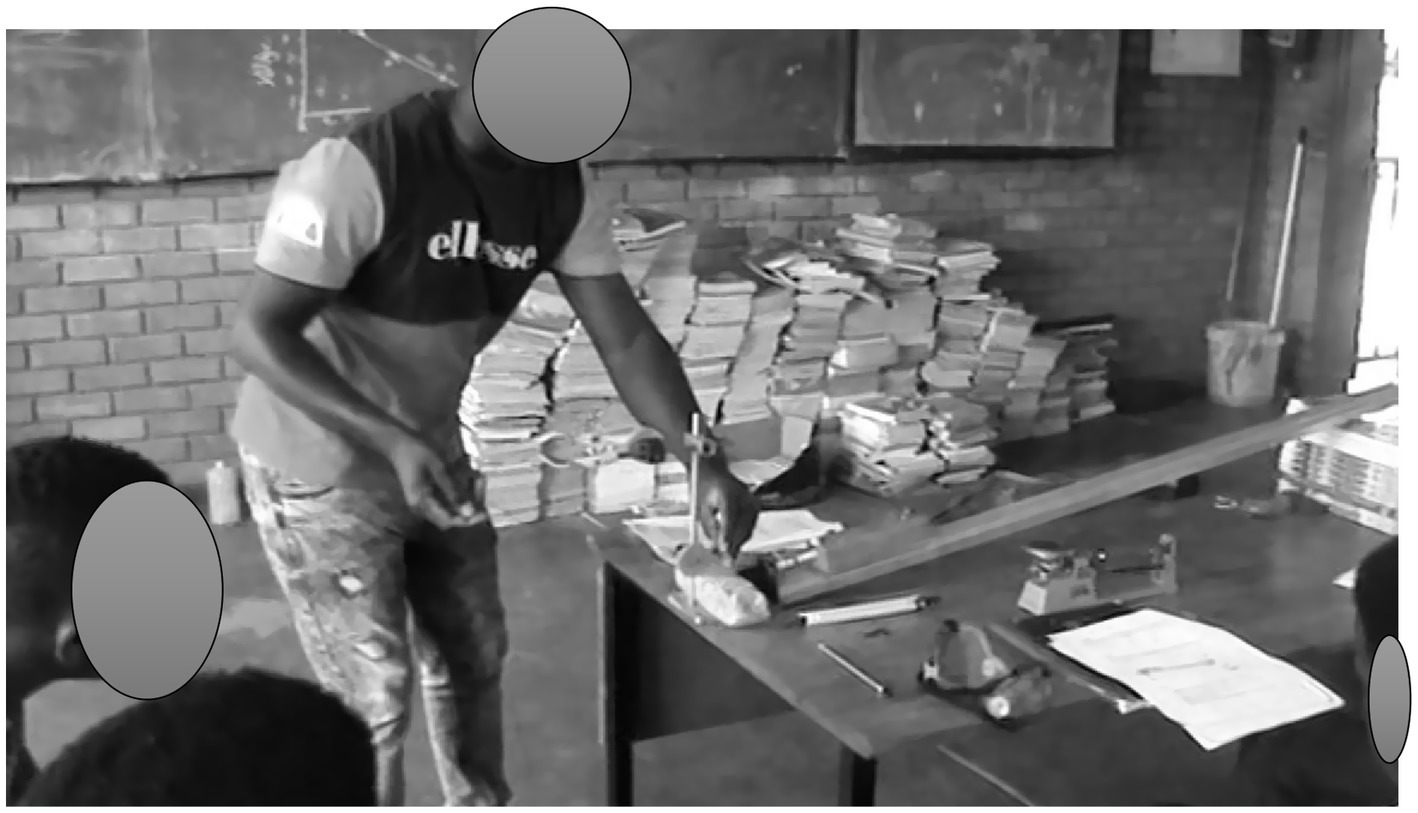
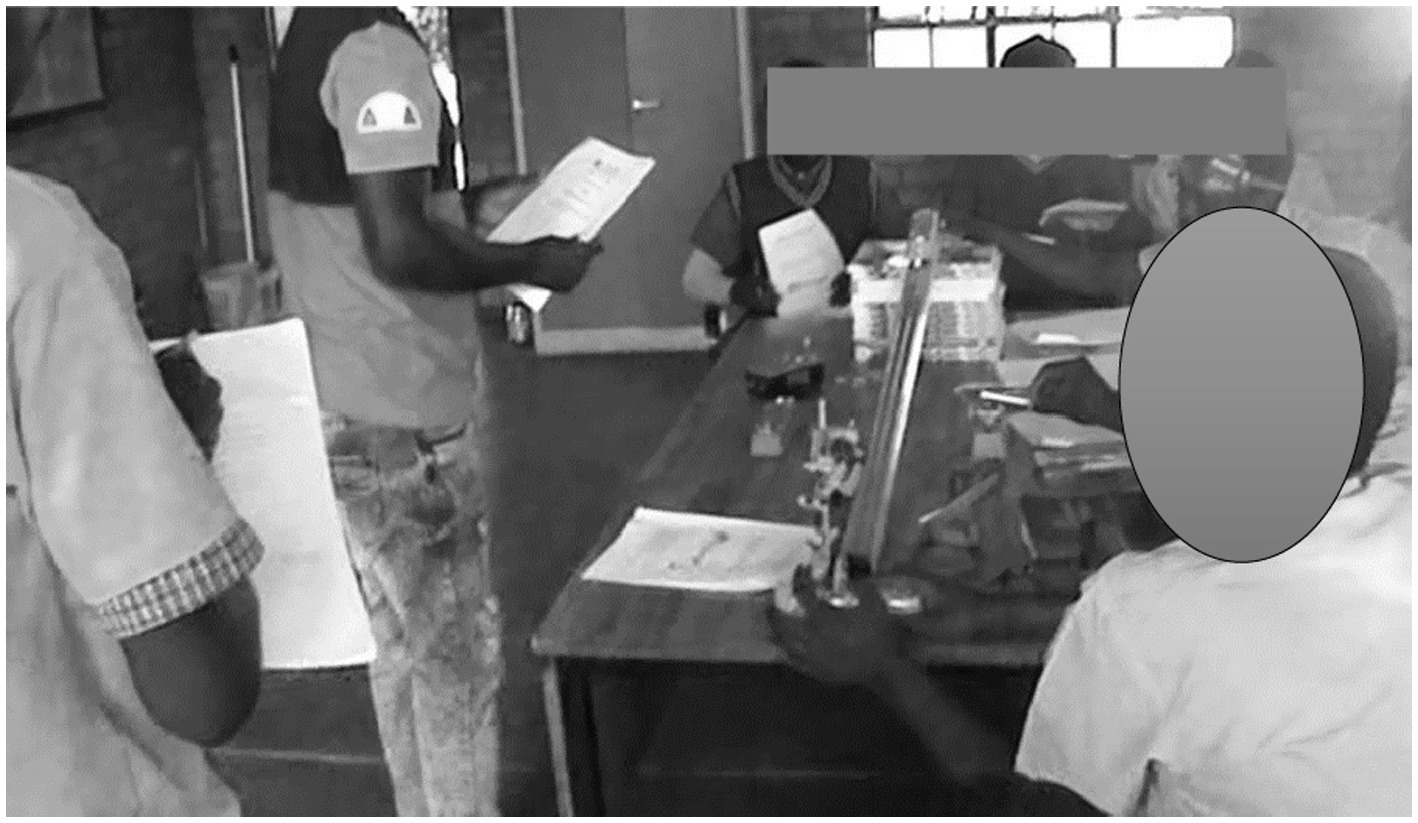
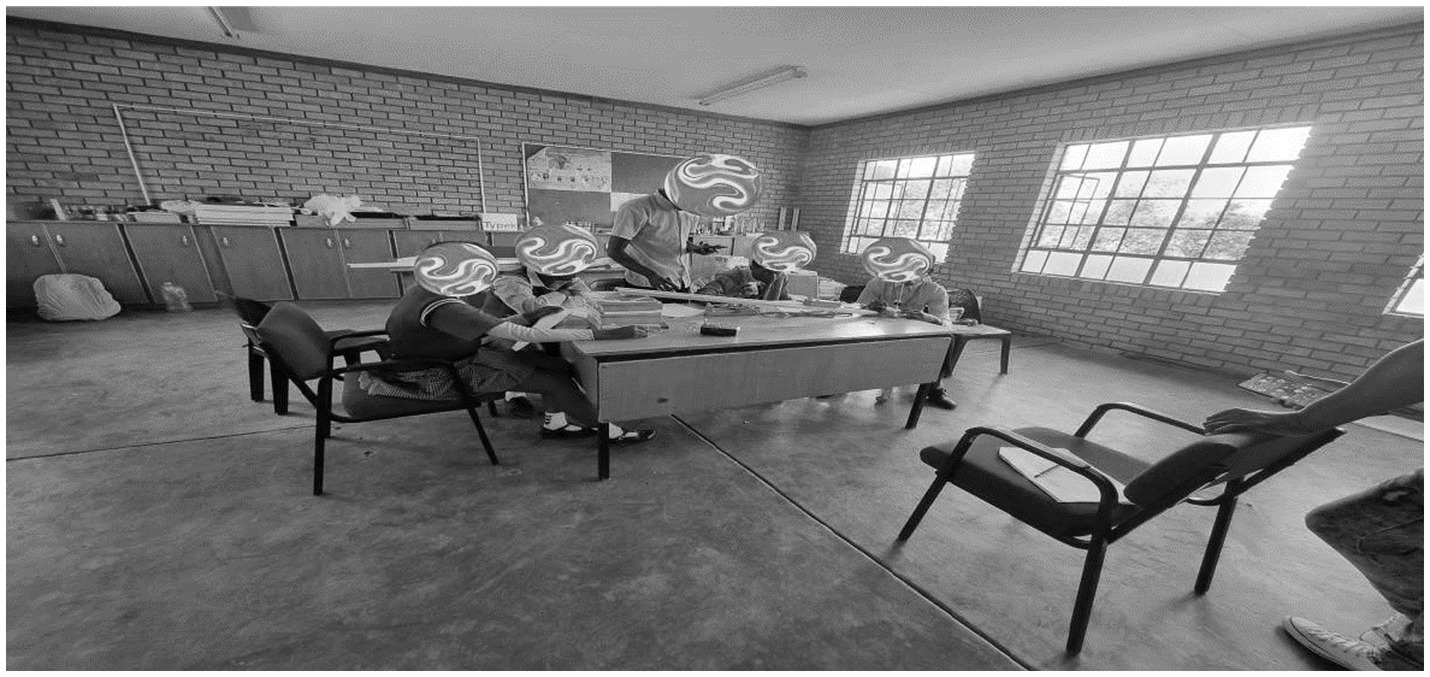

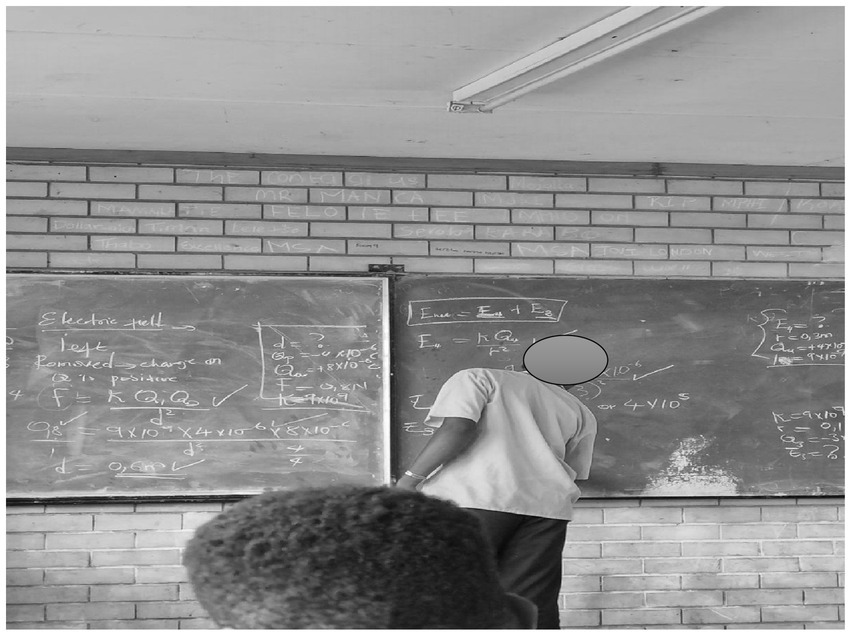
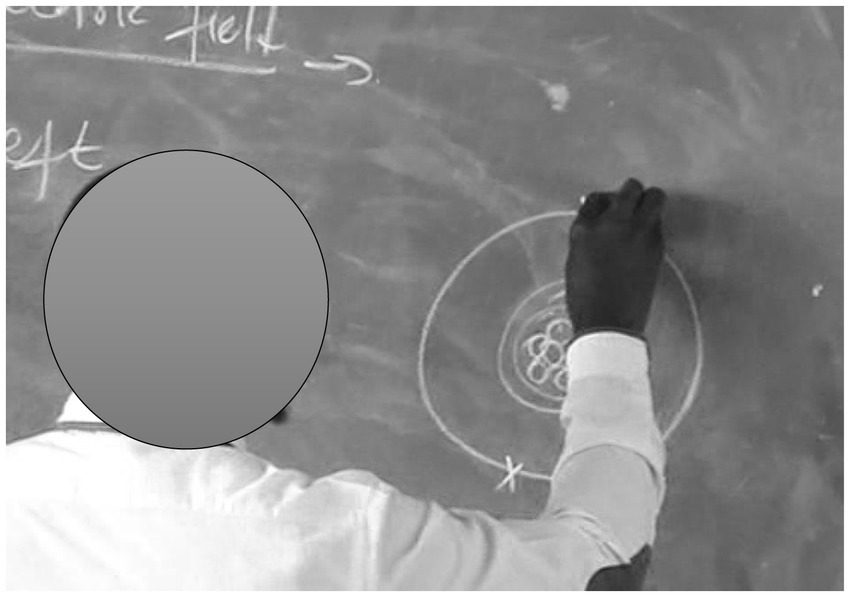
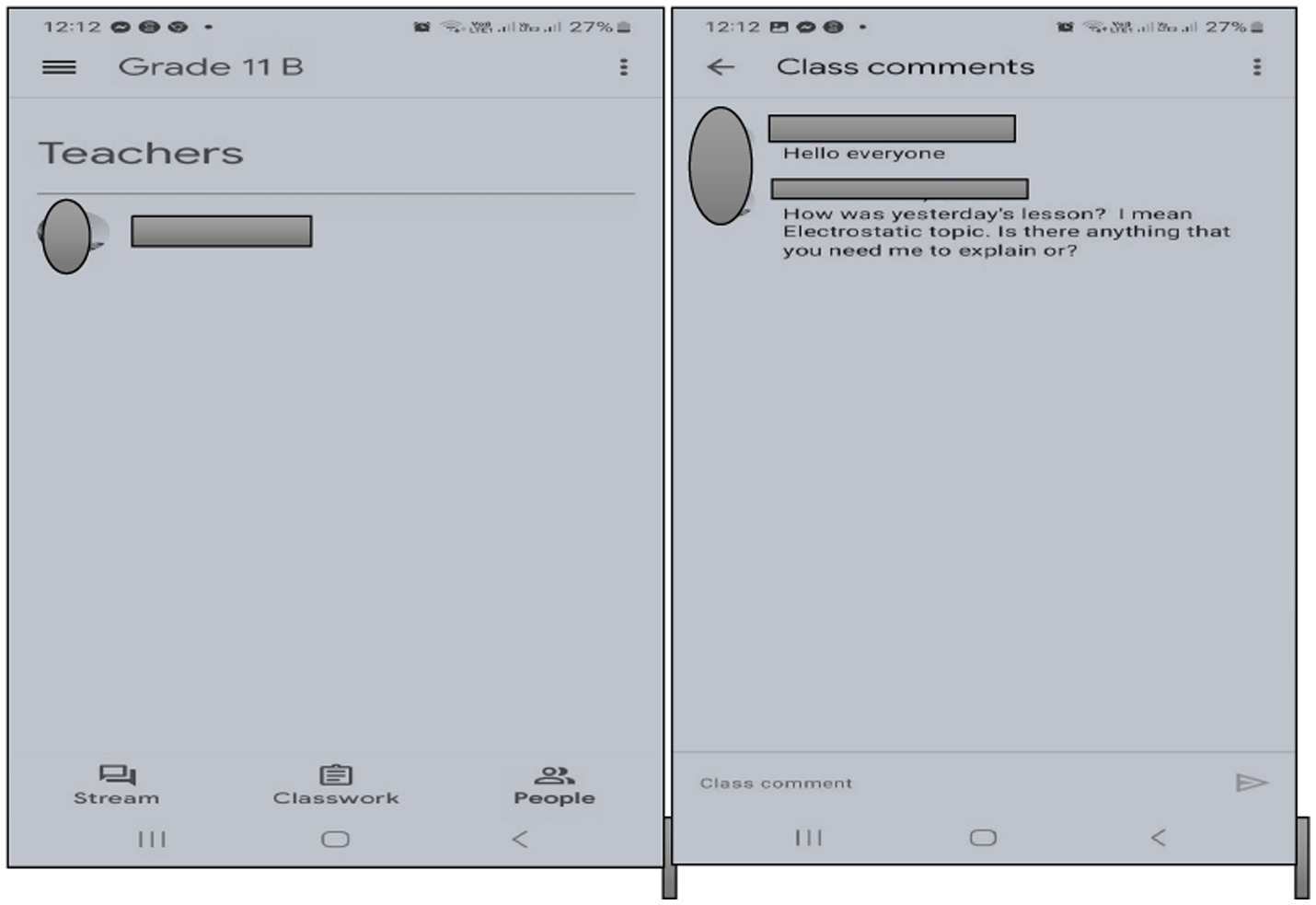
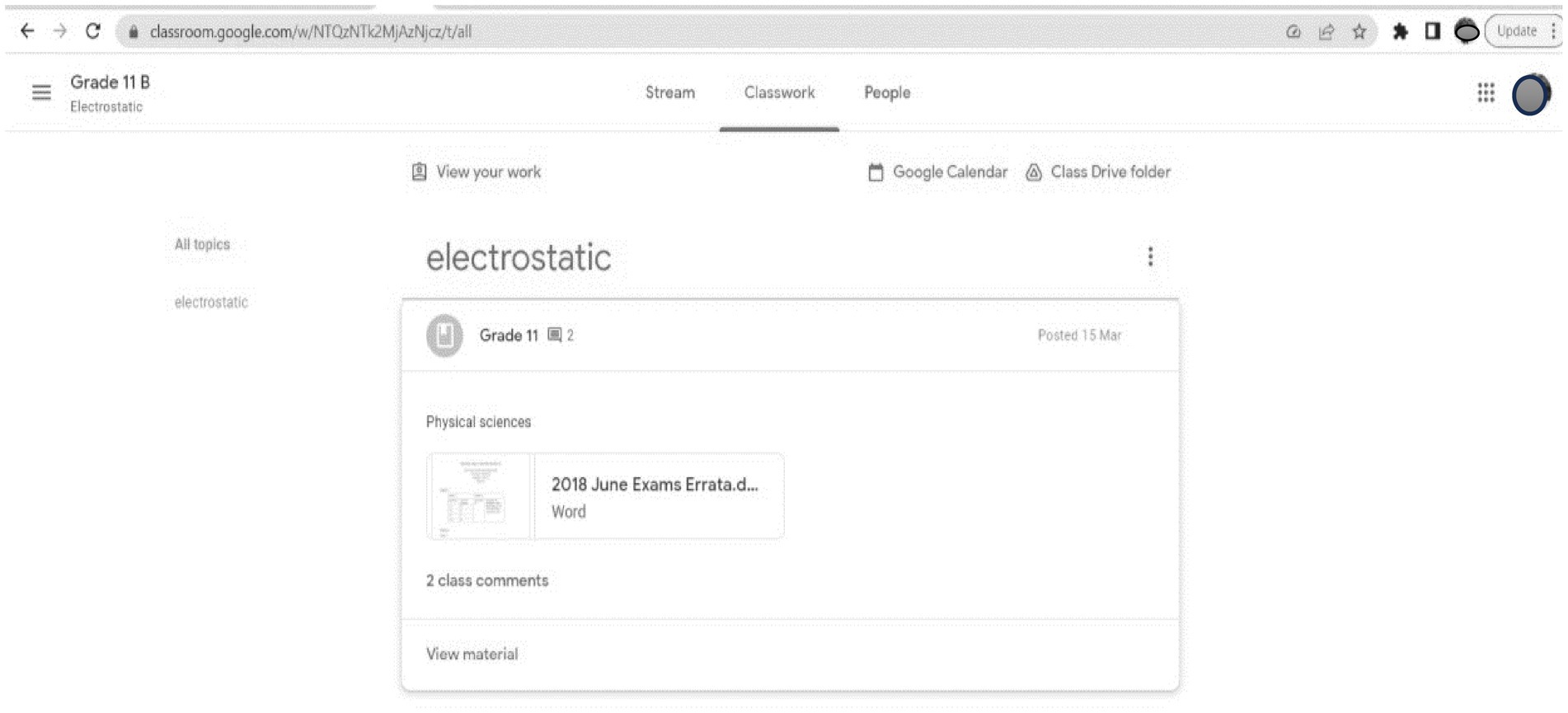
![A WhatsApp chat screenshot shows a conversation in a group named “Grade 11 physical...”. The chat shows timestamps and includes text and a voice message about waiting for an activity. Participants express thanks and mention waiting for someone named Mr. [name redacted]. The phone interface displays icons for video call, call, document attachment, and a send message bar at the bottom.](https://www.frontiersin.org/files/Articles/1595770/feduc-10-1595770-HTML/image_m/feduc-10-1595770-g012.jpg)
